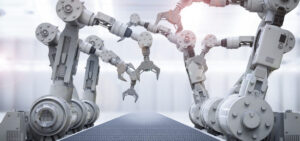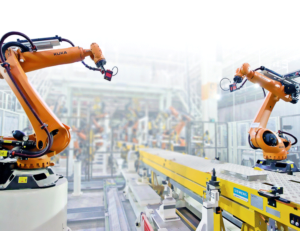
The year 2018 was quite eventful for the entire robotics industry. From the shutdown of Rethink Robotics to exciting products from Boston Robotics and the launch of self-driving cars from Waymo, there were several ups and downs for the industry.
Industrial robots, in particular, have seen increased adoption over the past year. In 2017 alone, 380,550 units were sold according to the International Federation of Robotics (IFR), which was 29 percent more than the year previous to that. China had led the growth, with the US and Germany close behind. As we await a final report of 2018, growth is expected to have increased further.
Speaking of trends that were seen in 2018, few major points can be raised.
1. Less Volume, More Variety
Gone are the days when manufacturing was just about producing a single product in large quantities. Today, there is more emphasis on smaller quantities with more variations.
Continuation of the shift from making large volumes of the same product to making much smaller lots of greater variety, e.g. ‘mass customization’ which has become the new normal in industries from automotive to electronics to even foods. This means factories need to be more flexible to accommodate a wider variety of products and packages on the same production line and to switch with agility between products. Many manufacturers struggle with this and find old, proven automation solutions are no longer flexible enough to help them keep pace with all this change.
2. Increased Flexibility
What such a refocus and the pressures that came with it have done is that they have increased investments in more efficient and flexible robot automation solutions in ‘lighter’ industries such as food and beverage or electronics manufacturing.
In food and beverage, robots were traditionally used to automate simpler processes like loading packages onto pallets. Today they are increasingly used for higher value processes, e.g. directly preparing the food. In electronics, which has very high mass customization, robots are helping balance the imperatives of flexibility, high quality, and fast cycle times.
3. Workforce Influence
Automation investments are being driven by changes in the workforce. Many countries today face a ‘demographic time bomb’ – they have aging populations approaching retirement and little relief in the pipeline as young people want mentally rewarding challenges, not physical ones. Many countries and industries are already experiencing labor shortages and skills gaps, or will be in the coming years.
People are less willing to do jobs which are dull, dirty, dangerous or delicate. Many manufacturers are using automation to offset labor shortages, especially to accommodate peak demand or in industries with unattractive jobs that have high turnover. The days of chasing cheap labor around the world are over – global manufacturers need to be able to produce with consistency, close to end users.
4. Evolving Technology
Finally, the industrial robots industry has also been influenced by the changes in demand for new technology. For instance, even in mature and highly automated industries such as automotive, there is continued investment being driven by the need for an efficient transition from internal combustion vehicles to electric vehicles.
This requires new manufacturing processes in traditional areas like the powertrain, as well as entirely new processes for areas like battery assembly automation, which is very complex and needs to accommodate many design variations. Carmakers are also looking to robots to automate areas of manufacturing that have traditionally been very manual, such as the final trim and assembly on a car. In the past this involved tasks that were difficult to automate, such as connecting all of a car’s delicate electronics.
5. The Future of Industry Robots

Industrial robots are becoming more popular than ever as customers become increasingly aware of their benefits at a time when labor costs continue to rise. Reports suggest that the research firm IDC expects spending in the robotics and drones sector in 2019 will be 17.6 percent more than what was seen in 2018. A CAGR of over 20 percent is projected to 2022.
ABB, one of the major players in the field of industrial robots, expects changes in three major areas in the coming year. What could happen in 2019?
5.1. Simplification
Gone are the days when industrial robots came with complicated installation and operation procedures and needed to be kept in separate enclosures. With several new innovations, machines have become simple enough to operate alongside humans without raising safety concerns.
ABB sees an increase in making robots that are easier to install, program and operate. Examples include programming by demonstration, use of tools like augmented or virtual reality, and better human/robot interfaces. In computer science, programming by demonstration is an end-user development technique for teaching a computer or a robot new behaviors by demonstrating the task to transfer directly instead of programming it through machine commands.
This is especially important to small and medium enterprises, where lack of robot experience is a key entry barrier. Simplification is also important to large global manufacturers, who want to open local factories with consistent quality regardless of the local labor pool.
Such a development is becoming extremely significant as more manufacturers face shortages of willing workers, for instance in industries with high turnover for low-skill jobs, where increasingly complex automation systems need to be easy to operate for new workers without extensive training.
5.2. Collaboration

The industry may also see an increase in applications (not just cobots) that allow people and robots to interact more, from safe coexistence in the same space to cooperation on shared tasks. Cobots have already revolutionized the way robots function in factories.
Collaboration is critical to increasing manufacturing flexibility to accommodate high mix, low volume production. People can add their unique ability to adapt to change and improvise, while robots add tireless endurance for repetitive tasks. Safe coexistence is increasingly important as high mix/low volume production means people need to work in close proximity to robots in more sporadic and intermittent ways — e.g., bringing robots different materials, changing programs and inspecting new runs.
Many manufacturers are struggling to balance the imperative of safety with the need to keep robots running at full speed. An added benefit of safe human/robot coexistence is that it allows more flexible factory production flows that are not constrained by safety fences. For example, goods no longer need to follow rigid, linear assembly lines — they can move organically through a factory through different applications to be tailored — sometimes in lots as small as one.
5.3. Digitalization
Connected devices are a single major trend in most industries at the moment. In the coming year, we may also be able to see connected robots in the digital manufacturing ecosystem.
This is improving efficiency, productivity and reliability through the entire production cycle (engineering, commissioning, operating and maintenance). Digitalization enables greater collaboration across the value chain either horizontal (e.g., between supplier, manufacturer, and distributor) or vertical within a factory (e.g., between e-commerce front ends and CRM systems, business ERP systems, production planning and logistics automation systems). Both of these types of collaboration can create better customer experiences and increase manufacturing efficiency.
A simple example is that a global manufacturer can look at the performance of individual robots among thousands across the world and identify weak performers which might need upgrading or servicing to produce at the same level as top performing robots in their fleet. Digitalization is important to meet high mix/low volume production, for example, greater engineering efficiency to switch with agility between products or launch new offerings faster.
Adapted from: a&s Magazine



































































